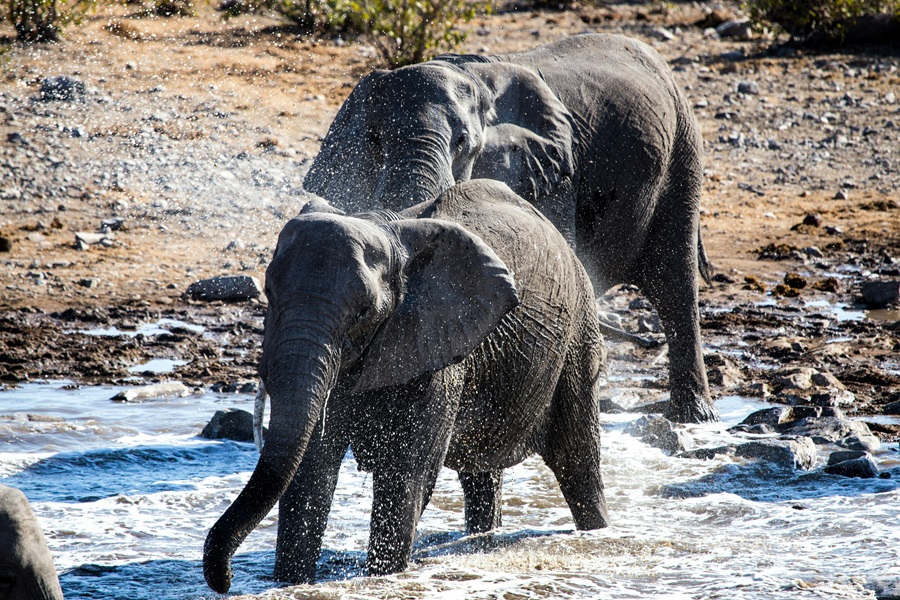Over 160 elephants of Zimbabwe, residing in the Hwange National Park, a sanctuary for endangered species, succumbed to starvation between August and December last year, due to severe drought conditions, raising concerns among conservationists about the possibility of more casualties as the hot, dry weather persists.
The Zimbabwe Parks & Wildlife Management Authority (Zimparks) confirmed these distressing deaths, attributing them to the dire effects of the prolonged drought.
“We have been doing tests, and preliminary results show that they were dying due to starvation. Most of the animals were dying between 50m and 100m from water sources.” Tinashe Farawo, a spokesperson for Zimparks, said on January 16.
Zimbabwe is home to an estimated 100,000 elephants and Hwange alone is believed to have half of them.
Persistent dry weather in South Africa
Southern Africa is grappling with persistent dry weather, exacerbated by droughts and extended dry periods.
Hwange Park experienced a severe lack of rainfall from February to November in 2023, leading to low nutrition, soaring temperatures, and water shortages that induced significant stress among the wildlife, according to Trevor Lane, the co-founder and head of the Bhejane Trust conservation group inside Hwange.
The National Oceanic and Atmospheric Administration’s forecast of a strong El Niño between October and March further fuels concerns of continued hot, dry conditions and minimal rainfall.
By the close of 2023, it said, “the greater part of Zimbabwe had received less than 50% of the seasonal accumulated rainfall when compared to the long-term average”.
Conservation groups in Hwange are now working fervently to mitigate the impact by drilling additional boreholes, installing solar-powered systems, and strategically placing resources to encourage elephants to move towards areas with more abundant food sources.
“We are aware that we might have an El Niño and a big drought in 2024,” Lane said. “We will see what we can do to mitigate that, but it will just be survival of the fittest … if there’s another drought we’ll have to go through the same thing again.”
History repeats
Unfortunately, history repeats itself, as droughts have previously caused mass elephant die-offs in Zimbabwe, with more than 200 elephants perishing in 2019 due to water scarcity.
As the climate crisis intensifies, the possibility of such devastating losses becoming the new normal is a dire concern.
Rise in poaching
The situation is compounded by a resurgence in poaching, with six elephants recorded dead in January near Hwange Park, victims of illegal wildlife trade and ivory poaching.
Lane said there has been a “general increase in bushmeat poaching, which from our own experience and [that of] other organizations can be attributed to the economic situation” in Zimbabwe. “People are getting desperate and resorting to the poaching of wildlife,” he said.
Elephant population in Southern Africa
The elephant population in Southern Africa is estimated at 227,900, according to the results of the first-ever aerial survey announced in 2023. The aerial survey completed using seven fixed-wing aircraft covered Angola, Botswana, Namibia, Zambia and Zimbabwe in the world’s largest conservation area, spanning 520,000 square kilometers, in a region known as the Kavango-Zambezi Transfrontier Conservation Area. This area is nearly the size of France.
The survey found that Botswana has the largest elephant population at 131,909. The survey, conducted during the dry season, between August and October in 2022, showed that the elephant population is stable overall.

Elephant Facts
- Elephants are the largest land mammals on earth. They can be found on both the African and Asian continents.
- The largest populations of African bush elephants are found in Botswana, Kenya, South Africa, Zambia, and Zimbabwe. Asian elephants can be found in India, Nepal as well as China, Cambodia, and Vietnam.
- There are three species of elephant: African Savanna (Bush), African Forest and Asian.
- African bush elephants can weigh as much as 6,000 kg (13,230 pounds) while an Asian elephant can weigh up to 4,000 kg (8,820 pounds).
- Elephants eat grasses, leaves, shrubs, fruits and root. An adult elephant eats up to 150 kg (or 330 pounds) of food every day. In the wild, they spend up to 60% of the day foraging for food.
- Elephants need hundreds of liters of water every day. On average, each elephant drinks about 100-200 liters or 25-50 gallons of water.
- Elephants need water for more than drinking. They swim and spray their skin with mud and water to cope with the heat.
- Wild elephants are always on the move. Most of them cover at least 25 kilometers every single day. Some have been known to traverse almost 200 kilometers in one day.

How many elephants are left in the wild?
There are approximately 465,000 elephants left in the world. The populations in Africa account for 415,000, with about 40-50,000 in Asia, mostly in India.
A century ago, African elephants numbered 12 million. Today, only about 400,000 remain, according to WWF.
Around 90% of African elephants have been wiped out in the last century, largely due to the ivory trade. In recent years, over 20,000 elephants have been killed annually in Africa, primarily for their tusks.
Amidst these challenges, the Zimbabwe Parks & Wildlife Management Authority reassures the public of its commitment to tackling poaching through stringent law enforcement and patrols.
However, the struggle against these interconnected crises – drought, climate change, and poaching – remains an uphill battle, posing a threat not just to the elephants but to the delicate ecological balance of the region.
Zimparks said that it was “on top of the situation when it comes to poaching” of elephants in Zimbabwe. “We have not been losing many animals. In Hwange, we haven’t recorded any poached elephants in the past two years. We need to continue doing law enforcement and patrolling,” said Farawo.

